Beekeeping - Beehive yourself!
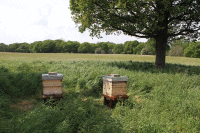
Whilst the debate lingers on, the popularity of beekeeping is on the rise, with more and more people helping the plight of bees by getting involved in conservation projects to increase populations. Ten years ago, the British Bee Keepers Association (BBKA) had only 10,000 members. That number has risen to a substantial 24,000, many of whom are from urban areas.
It is a well known fact that all bees, whether they be solitary, bumble or honey, are in danger of disappearing from our environment. The loss of natural habitats to anthropogenic needs has seen vast areas transformed into motorways, dual carriageways, housing estates, shopping centres, office buildings and industrial estates, to name a few, which are all major threats to bee populations, whilst agricultural practices continue to disturb the foraging capabilities of solitary and bumble bees, leaving both species little or no chance of re-establishment.
The honey bee is also under attack from the Varroa Mite (Varroa destructor) and it is the care provided by beekeepers that is keeping colonies alive. Most feral honey bee colonies have died out as a result of this disease. It is estimated that, should a colony establish itself in the wild, it will only last approximately three years before being wiped out.
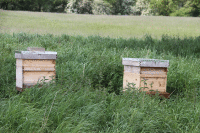
As more and more people have taken up beekeeping, others have helped by encouraging better management of land assets. In recent years, we have seen a good number of greenkeepers and groundsmen changing their working practices to embrace ecological concerns to help increase bee activity on their golf courses and grounds. This has come in the form of changing mowing regimes, creating wildflower areas and planting flowering plants and trees that attract bees for their pollen.
Ed Ainsworth, Course Manager at Avro Golf Club in Stockport, is one such greenkeeper who has taken the extra step and, through his own dedication and learning, has become something of a 'bee expert' over the last five years. He has even been offering his services to fellow greenkeepers to help set up new bee colonies.
Ed now advises at five golf clubs who have shown an interest in keeping bees or allowing the set up of bee colonies on their course. These include The Belfry, Cheadle Golf Club and Wilmslow Golf Club.
Regular readers may remember that we featured Ed's work in issue 53, in which he explained how he was attracted to beekeeping in the first place.

As soon as Steve had decided he was going to set up a new bee colony, he enlisted the help of Ed to undertake the work and two hives were purchased. Next was to source a supply of bees.
It is important to understand the principles of beekeeping and being aware of the hard work, commitment and responsibility required. Initial costs can run into hundreds of pounds; a typical cedarwood hive will cost in the region of £500 to build.
A mature colony is usually housed in a three or four tier hive - the ones at Wilmslow currently have two tiers - housing a brood box and honey box.
The queen bee remains in the brood box and is prevented from straying into the honey box by a filter grid or queen excluder. This metal frame structure allows worker bees to pass, but prevents the queen from moving upward in the hive, ensuring that all upper hive levels are reserved exclusively for honey storage.
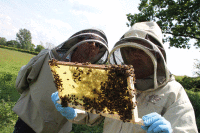
Honey bees swarm because they are looking for a new site to form a new colony. It is a natural means of population increase and each swarm contains a queen bee and up to 20,000 worker bees
The swarming season is from April to July, but the peak is from early May to mid June; swarms are not dangerous unless disturbed or aggravated. After surviving a cool winter, a bee colony can expand up to 50,000 worker bees in the warmer weather, living with a queen bee, which produces a "queen pheromone". With thousands of bees living together, not all of them receive the queen's pheromone signals - and so create a new queen.
The old queen and flying bees then leave their home to establish a new nest, however, before leaving, they gorge on honey, which means that, when they are swarming, they are usually in a semi-docile state.
There are three ways to populate a new hive; getting bees from a supplier (via the post), where you are sent a queen bee and up to 3,000 bees; catching a swarm of bees or splitting an established hive.
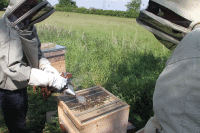
Since their implementation, Ed has been instructing Steve and Tim Johnson, one of his assistant greenkeepers, on the rudiments of beekeeping, making sure they have a hands-on approach.
The two new hives have been sited underneath the canopy of a large oak tree, providing the shade they will need during the summer. The site is very important as hives need to be in an area that offers them plenty of foraging material. Additional to this, the hives need to be in a place that protects them from the elements, particularly strong winds, should be kept away from the general public and, most importantly, the bees need access to water.
Why water? Bees need water to dilute their own honey before they can eat it. During production, the bees drive off the water from nectar, whilst it is converted to honey by enzymes. The finished honey becomes stable when the water content falls below 20%, making the sugar concentration high enough to prevent fermentation by natural yeasts. At this concentration, however, the bees cannot eat the honey. The adult bees dilute the honey before they eat it and when preparing the brood food (a dilute mixture of honey or nectar and pollen). The worker bees also use water to help regulate the temperature of the hive by releasing water inside, which evaporates to cool the hive. A colony that struggles to find sufficient water will often not survive.
The opportunity to see a bee colony close up was a new experience for me. Ed proceeded to get us dressed with bee suits to protect us and, additionally, the bottoms of my trousers were gaffa taped. Once we had slipped on the gloves, we walked calmly towards the hives and, after a couple of puffs of smoke to calm down the colony, were able to open up one of the hives to reveal the active bees.
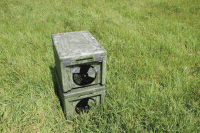
Hive inspections start as soon as the weather warms up in early spring, i.e. when temperatures reach at least 15OC and with no significant wind. Opening up a hive in cold/windy conditions may kill the brood or set back the development of the colony.
Early inspections should be concerned with looking at the health of the colony. Is there a laying queen - is there a consistent pattern of eggs to be seen? Do the larvae look healthy - pearly white and in a nice 'C' shape? Are there sufficient stores to maintain the colony?
The presence of a good, consistent pattern of eggs in the central parts of the frames will indicate the presence of a laying queen so, in this case, it was not necessary to find her. However, it proved to be a good time to mark the queen, as there were a relatively small number of bees, making her easier to find later on. This was done with red and blue paint.
If no eggs are present, then the colony might be queenless. If this is the case, the colony will need a new queen or require uniting with a queenright colony - a colony where a queen exists.
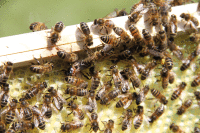
An inspection of every frame was carried out by Ed and Steve to gauge the health of the bees and check that they were building up their stores. A close inspection of the brood box was undertaken to locate the queen, which proved fairly straightforward as Ed had painted a red/blue mark on her back.
Once she was located, we were able to close up the hives, leave the bees in peace and allow them to get on with building up their colony. During the following weeks, the bees will be busy sourcing nectar, converting this energy into both new cells for breeding and storing their honey.
As forage (nectar and pollen) becomes more readily available with early spring flowers, egg laying by the queen will increase sharply. The colony will continue to increase throughout spring and into summer, going from something like 5,000 bees in winter to 40-50,000 bees by midsummer. The net result of this growth is an abundant supply of honey. A typical hive can produce between 60-150 lbs of honey per year - a nice trade off for all the hard work - and Steve is hoping that enough honey will be produced to keep many of his members happy.
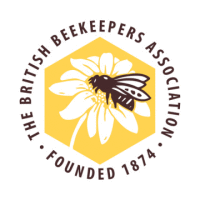
It is not until you see the scale and precision of how these bees operate that you clearly understand one of the wonders of nature.
Useful websites:
BBKA: www.bbka.org.uk
Keeping Bees - Apiary Set Up: www.barnsleybeekeepers.org.uk/apiary.html
Getting Started
Before you can start thinking about putting hives on our golf course, you will need to get your committee on board. This may include putting on a 'bee talk' for your members and educating them on the importance of bees and the benefits they bring, not only to the golf course but to the countryside as well. It's also a good idea to inform them that they will be able to purchase cheap, pure honey from their very own golf course. I find this helps sweeten them up.
Getting a local beekeeper to help with the presentation is a good way of helping you to encourage your members and committee in supporting you.
Contacting the local bee association will help in many ways, giving you hands on experience of manipulating a hive of bees with expert advice and instruction. The association also conducts a fourteen week beekeeping course, which is spread over ten weeks of two hour theory sessions, and then four weeks working closely with the association's own hives.
After completing the course, you will be given advice on buying your bees and possible contacts of other beekeepers with colonies to sell, plus the assurance that these bees are free from disease and reliable.
You will also be paired with a mentor whom you can call on for advice or practical help if confronted with a situation which is new to you.
Access to the association's library, plus the loan of a honey extractor and monthly meetings and apiary visits are also available.
During the course, you will be given advice on the types of hives available, sources of equipment and type required, setting up an apiary, getting your bees and collecting and moving them.
Getting Your Bees
Once you are a member of the association, they will be able to give you advice before committing yourself to a purchase, and may assist in looking through the bees with you to ensure they are in good health and disease free.
In my opinion, a nucleus colony is the best way for any beginner to start.
A small colony will be easier to handle initially, and will, hopefully, not try to swarm in your first year. It will give you great pleasure to watch it build up. There may not be much honey in your first year, but a lot of good practice and confidence will be gained. After you have gained experience from your first season, you should consider introducing another colony as any problems can be rectified more easily with resources from another colony.
Nucleus Hive
A small starter colony is known as a 'nucleus', because it should grow into something bigger! A hive for such a colony is, therefore, known as a ''nucleus hive' or, for short, a nuc. These are small hives that usually hold five or six brood frames. They are very useful for a number of purposes and every beekeeper will probably eventually feel the need for one. You can use a full hive, but a nuc is cheaper and smaller.
An experienced beekeeper will use a nuc for; holding a swarm, breeding new queens, holding small colonies, creating a colony from a new queen and creating queen-mating colonies.
Setting up your Apiary
Seek advice from an experienced beekeeper to help you before setting up your apiary. The Beekeepers Association have a leaflet - Choosing an apiary site - which will guide you during this process.
Some important points to consider whilst setting up your apiary are; always site hives where the bees' flight path will not interfere with golfers, ensure that the apiary is on level ground and that there is good access for you. Access is important when transporting frames due to their weight.
Try to ensure that hives are given early morning sun and are not situated in a damp, shaded position. Water is also important to bees, so a pond or even a bird bath can be used to aid the bees. If using a birdbath, stones/peddles should be added to aid the bees as they will be able to stand on the stones to drink the water.
Always keep your apiary site clean. Do not drop discarded wax or syrup. If you do, pick or wipe it up. Have a plastic container to hand for such debris - the wax can be rendered and will probably be worth having.
Looking forward to our next article on Beekeeping on a Golf Course, we will be looking into building up a nucleus colony, hive inspections, equipment required and bee stings.
Edward Ainsworth, Head Greenkeeper, Avro Golf Club, Stockport



